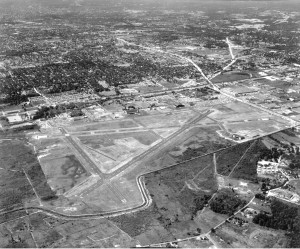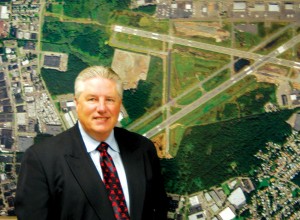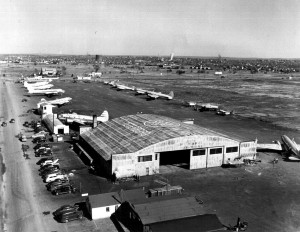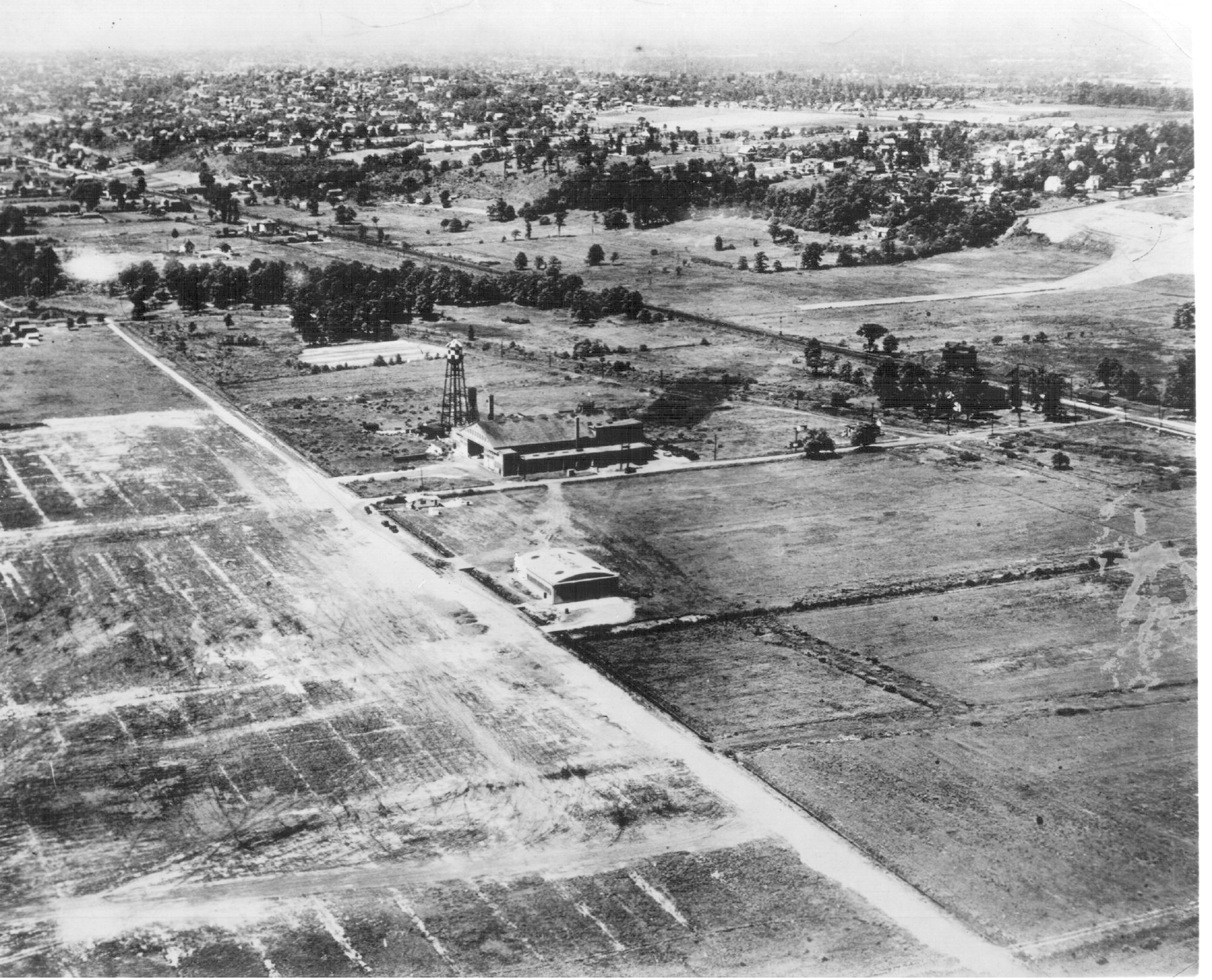By Henry M. Holden

The original Teterboro Airport is seen here in the mid-1920s. Eighty years later, it would be unrecognizable as civilization crept toward it.
Teterboro Airport (TEB) is the oldest operating airport in the New York and New Jersey metropolitan area and the country’s third busiest GA airport, based on total operations. It’s a typical example of the nation’s GA airports dealing with issues of security, encroaching strip mall development, operating restrictions, expensive technology upgrades, accidents in populated areas and noise restrictions.
Teterboro Airport was built on farm land acquired by Walter C. Teter in 1917. During World War I, North American Aviation operated a manufacturing plant on the site. The first flight from the airport was made in 1919. After the war, the airport served as a base of operations for Anthony Fokker, the Dutch aircraft designer.
During World War II, the Army Airforce operated the airport. On April 1, 1949, the Port Authority of New York and New Jersey purchased it from Fred L. Wehran, a private owner, and later leased it to Pan Am World Airways and then to Johnson Controls, for 30 years. On Dec. 1, 2000, the Port Authority assumed full responsibility for operations at TEB.
“The airport captures its own history and that of the entire aviation industry with the on-site Aviation Hall of Fame & Museum.” said Steve Riethof, the museum’s executive director. “The museum was founded in 1972, and it’s the first state aviation hall of fame in the nation. We honor the men and women who brought outstanding aeronautical achievements to the state.”
Visitors have an opportunity to view historic air and space equipment, artifacts, photographs, fine art and an extensive model collection. The library has more than 4,000 books and hundreds of aviation video tapes. The museum documents the rich 212-year history of New Jersey aviation.

Seen here around 1960, the neighborhood is edging toward the field. Runway 1 would be extended to accommodate the arrival of the jet age, and Runway 32 was shut down and became a taxiway. Runway 24 (far right center) would be extended almost to the fence.
“In the first decades of aviation, New Jersey was a center of development and record-setting flights,” said Riethof. “During this period, most of the aviation legends of the day could be found in the skies over New Jersey. Many flew out of this airport. Charles and Ann Morrow Lindbergh, Amelia Earhart, Admiral Richard E. Byrd, Wiley Post, Howard Hughes and Jimmy Doolittle all used the airport.”
With this fame also came a bit of notoriety. In January 1954, radio and TV personality Arthur Godfrey buzzed the Teterboro control tower with his DC-3.
“His license was then suspended,” Riethof said.
In 1973, Teterboro Airport voluntarily applied for and received a certification for safety under Part 139 of the Federal Aviation Regulations. It was the first general aviation airport in the nation to have this certification. Under it, the airport operator must meet the FAA prescribed operating and safety standards that are followed at air carrier airports.
As the 20th century unfolded, and especially after World War II, the farms and open fields of New Jersey beckoned New Yorkers and others to move west, across the Hudson River. Homes, apartment buildings and industries crept slowly toward the airport. Today, every available square yard of land is occupied in one way or another; that is now causing problems and increasing the angst of the community.

This recent photo of Teterboro shows the community at the gates of the airport. Runway 24 is barely 250 feet from a major U.S. highway and there’s a warehouse where there was once an empty space across the road.
The airport sits on 827 acres of land surrounded by anxious residents and businesses. There are 90 acres used for aircraft hangars and offices, 408 acres for aeronautical use and runways, and 329 are undeveloped. The two-runway configuration does little to relieve the worried nearby residents. Runway 1-19 is 7,000 feet long, and its ILS approach is over homes and an industrial park. The 6,015-foot Runway 6-24 has barely 250 feet of overrun between it and U.S. Route 46, a major highway leading into New York City.
With the airport only 12 miles from Manhattan, and with the community literally crowding at the gates of the airport, security had always been a concern at TEB.
“After the terrorist attacks on Sept. 11, 2001, the airport was closed for a week, and then we opened to only Part 135 operations (commuter and on-demand operations) for about a month,” said Lanny Rider, the airport manager. “We’re about 70 percent Part 91 operations (private aircraft operations), so 70 percent of the business was shut down for a month. While we’re a general aviation airport, and that normally has lower security standards, we recognized that because of the size of the equipment here, and our proximity to Manhattan, we should establish our own security standards, which we did. The security arrangements in place exceed any Homeland Security or FAA requirements.”
Rider said that since 9/11, to reach any fixed base operation or facility that has direct access to the airfield, you have to go through a guard checkpoint before you can even get off the street.
“You can’t get into a parking lot without going through a guard post,” Rider said. “We renewed the ID card system so no one gets on the field without this ID card. All private vehicles are banned from the airfield. You either have to be under escort or take a company vehicle. No one can take their limo or private vehicle out to the aircraft.”

Lanny Rider, the airport manager, has been with the Port Authority since 1977. He has been at TEB since 2001, and prior to that, he was the airport operations manager at LaGuardia and airfield operations manager at JFK.
In recent years, there’s been increasing political and community pressure to limit and cut back airport operations. Some in the community would like to see it close. Politicians have proposed to the public a 25 percent cut in air traffic operations, a stricter nighttime curfew, and a reduction in the weight restriction from 100,000 pounds to a lower limit, as well as a ban on Stage 2 (noise level) jets.
“Currently, Stage 2 jets are a very small percentage, less than five percent of the fleet, but are the noisiest, and they create a disproportionate number of complaints,” Rider said.
Although it had long been voluntary, in 2003 U.S. Congressman Steven Rothman helped authorize a federal bill to stop aircraft exceeding a weight of 100,000 pounds from taking off from TEB, because there were excessive noise levels in the surrounding residential communities. Also in 2003, the airport briefly served as the base for Indigo Airlines, a “public charter” airline that offered daily flights to Chicago Midway Airport, in small jet aircraft. The private ground facilities offered much faster check-in times than airlines at other New York/New Jersey airports. Rothman pressured the Port Authority and Transportation Security Administration to shut down Indigo’s operations.
TEB supports more than 5,000 employees, about 1,200 of whom are on the airport. Twenty-two percent of the employees live within a five-mile radius of the airport, 62 percent within 10 miles and 94 percent live within 15 miles. Yet, there is much opposition to the airport continuing operations in the area, especially after four on-airport accidents (nonfatal) in four successive months in 2005. The accidents—especially the seriousness of them—have caused the community great concern, which has put pressure on airport management. The accidents have presented the community with an advantage when bringing up safety, air quality and noise issues.

The Aviation Hall of Fame of New Jersey has documented the history of Teterboro Airport. It contains memorabilia and artifacts dating back to the balloon and dirigible era.
The most serious accident, on Feb. 2, 2005, involved a Bombardier Ch allenger CL-600 jet departing for Chicago Midway Airport. The pilot aborted the takeoff, possibly because of icy conditions (the temperature was -6 C, but no final NTSB report has been issued), and the jet ran off the end of Runway 6-24, through the perimeter fence and across the adjacent U.S. Highway 46. It struck a vehicle and then crashed into a warehouse. Eleven people were on board the aircraft, including three crewmembers. Several people on the aircraft were injured, some seriously, and two people in the vehicle were injured.
“While the infrastructure of the airport is seriously restricted by the surrounding community, there are some things that were in the planning stages that we kicked up in the schedule,” said Rider. The accidents escalated the schedule of the engineered material arresting system, a safety overrun project. This is a foam arrester bed installed at the ends of the runways for overrun purposes.
“It’s in lieu of having a 1,000-foot safety area for runway overruns,” said Rider. “Runway 6-24 has very little distance between it and a major highway, Route 46. There’s no way to grow a 1,000-foot overrun, so we’re installing these arrestor beds instead. It’s solid foam, but made out of aerated concrete with a constancy of Styrofoam.”
The addition of the EMAS is expected to begin in the summer and should be completed by the end of 2006, on Runway 6-24. Another EMAS will be installed on Runway 1-19 next year. That involves rerouting a road to get more room.

The original control tower was replaced in 1972 by a new facility on the east side of the field. This building then served as the museum until a facility was built in the shadow of the new control tower.
“New technology will help us in the limited available space to stop an aircraft overrun,” said Rider.
Also upgraded was the crash fire equipment, and the airport added a new piece of equipment called a snozzle. The snozzle is mounted on a fire truck; combined with the articulation of the truck’s boom, it can penetrate the skin of an aircraft and apply firefighting foam into the aircraft without firefighters entering the aircraft. This foam isn’t like the Halon fire suppression system that takes oxygen out of the air, and it allows people to move through the foam.
“It would be used probably as a last resort, because it’s better if the people can be evacuated from the aircraft,” said Rider. “If there’s a lot of heavy black smoke, you don’t want to send firefighters into that kind of environment either. We used a snozzle from Newark for the February crash. It worked well, so we added one to our inventory.”
He said that in the past, the airport had civilian firefighters under contract, but they were replaced in December 2005 with Port Authority police.
“We have about 24 police officers who are trained to do crash fire rescue, and they also provide airport security,’ he said.
Rider said that general aviation is tied into the economy, and that the airport has been doing well since 2002.
“We were up to 202,320 aircraft movements in 2004, one of the highest years in the last 20 years,” he said. “We’ve seen a little bit of a drop off, to 197,035, in 2005, but that’s probably tied to the accidents, the political comments, the FAA’s comments and that sort of thing. It could be our (landing) rates also. They’re very high. Or it could be a combination of things.”

Teterboro as it looked around 1947, filled with war surplus DC-3s and Curtiss Commandos converted to passenger service. In the background is a DC-4.
The airport’s economic engine is chugging along at a healthy rate. The airport provides more than 15,500 jobs, $670 million in wages, and $1.8 billion in sales annually to the area. However, in aviation there’s always the possibility that no matter how hard we try, mechanical issues, human error, or adverse weather will rear its ugly head at the wrong time. The community has been learning to live with the daily specter of a worst-case scenario, but the ambiguous feelings run deep.
The community will not pack up and leave, and many hope the airport will not close because of its economic impact on the area. With those issues on the table, there’s an ongoing dialogue among the community, politicians and the airport. It’s hoped by all involved that the dialogue on safety, vigilance and economic issues will ameliorate the concerns of all involved.











